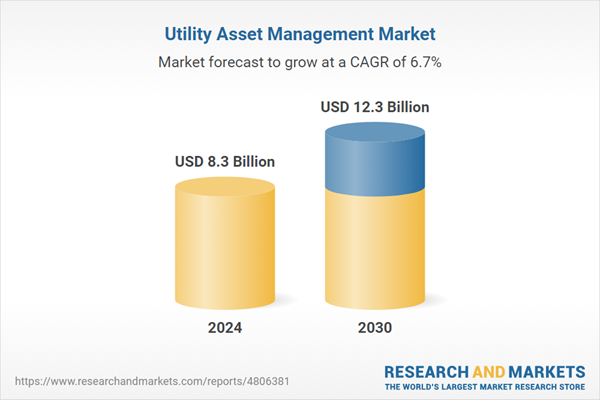The global market for Utility Asset Management was valued at US$8.3 Billion in 2024 and is projected to reach US$12.3 Billion by 2030, growing at a CAGR of 6.7% from 2024 to 2030. This comprehensive report provides an in-depth analysis of market trends, drivers, and forecasts, helping you make informed business decisions. The report includes the most recent global tariff developments and how they impact the Utility Asset Management market.
Segments: Component (Software, Hardware); Application (Transformer, Transmission & Distribution Lines, Sub-Station).
Geographic Regions/Countries: World; United States; Canada; Japan; China; Europe (France; Germany; Italy; United Kingdom; and Rest of Europe); Asia-Pacific; Rest of World.
The analysts continuously track trade developments worldwide, drawing insights from leading global economists and over 200 industry and policy institutions, including think tanks, trade organizations, and national economic advisory bodies. This intelligence is integrated into forecasting models to provide timely, data-driven analysis of emerging risks and opportunities.
Global Utility Asset Management Market - Key Trends & Drivers Summarized
Why Is Asset Management Crucial in the Utilities Sector?
Utility asset management is a critical component in the operation of utilities, encompassing the management of infrastructure assets such as power lines, transformers, pipelines, and water treatment plants. Effective asset management ensures that these critical assets are maintained, upgraded, and replaced in a timely and cost-effective manner, thereby maximizing their lifespan and minimizing the risk of failures that could disrupt service delivery. With utilities facing increasing pressure to improve operational efficiency, reduce costs, and ensure regulatory compliance, the role of asset management has never been more important. Proper asset management allows utilities to optimize their capital expenditure, improve service reliability, and meet the growing demands for sustainable and resilient infrastructure.How Are Technological Advancements Enhancing Utility Asset Management?
Technological advancements are transforming the way utilities manage their assets, making the process more efficient, accurate, and data-driven. The integration of advanced technologies such as Geographic Information Systems (GIS), asset management software, and predictive analytics is enabling utilities to monitor the condition of their assets in real-time, predict potential failures, and plan maintenance activities more effectively. The use of drones and remote sensing technologies for asset inspection is also becoming more common, allowing utilities to gather detailed data on the condition of their infrastructure without the need for costly and time-consuming manual inspections. Additionally, the rise of IoT-enabled sensors and smart meters is providing utilities with a wealth of data on asset performance, enabling more precise and proactive asset management strategies. These technological innovations are helping utilities to extend the lifespan of their assets, reduce maintenance costs, and improve overall service reliability.Why Are Utilities Increasingly Adopting Advanced Asset Management Solutions?
Utilities are increasingly adopting advanced asset management solutions in response to the growing complexity of their infrastructure and the need to improve service reliability and efficiency. The shift towards smart grids and the integration of renewable energy sources are adding new challenges to asset management, as utilities must now manage a more diverse and dynamic range of assets. In addition, regulatory pressures to improve the resilience and sustainability of utility infrastructure are driving the adoption of more sophisticated asset management practices. Utilities are also under increasing pressure to reduce operational costs while maintaining or improving service levels, making effective asset management a key priority. The ability to monitor assets in real-time, predict failures, and optimize maintenance schedules is helping utilities to achieve these goals, leading to widespread adoption of advanced asset management solutions.What Factors Are Driving the Growth in the Utility Asset Management Market?
The growth in the Utility Asset Management market is driven by several factors, including the increasing adoption of smart grid technologies, the growing complexity of utility infrastructure, and the rising demand for real-time asset monitoring and predictive maintenance solutions. The proliferation of IoT devices and smart meters is providing utilities with unprecedented levels of data on asset performance, driving the need for advanced asset management tools that can process and analyze this data effectively. Additionally, the shift towards renewable energy sources and the increasing integration of distributed energy resources are creating new challenges in asset management, leading to increased demand for solutions that can manage this complexity. The growing regulatory focus on improving the resilience and sustainability of utility infrastructure is also driving investment in asset management, as utilities seek to comply with these regulations while optimizing their operations. Furthermore, the increasing emphasis on reducing operational costs and improving service reliability is pushing utilities to adopt more sophisticated asset management strategies, further fueling the growth of the market.Report Scope
The report analyzes the Utility Asset Management market, presented in terms of units. The analysis covers the key segments and geographic regions outlined below.Segments: Component (Software, Hardware); Application (Transformer, Transmission & Distribution Lines, Sub-Station).
Geographic Regions/Countries: World; United States; Canada; Japan; China; Europe (France; Germany; Italy; United Kingdom; and Rest of Europe); Asia-Pacific; Rest of World.
Key Insights:
- Market Growth: Understand the significant growth trajectory of the Software segment, which is expected to reach US$7.2 Billion by 2030 with a CAGR of a 7.1%. The Hardware segment is also set to grow at 6.1% CAGR over the analysis period.
- Regional Analysis: Gain insights into the U.S. market, valued at $2.2 Billion in 2024, and China, forecasted to grow at an impressive 6.3% CAGR to reach $1.9 Billion by 2030. Discover growth trends in other key regions, including Japan, Canada, Germany, and the Asia-Pacific.
Why You Should Buy This Report:
- Detailed Market Analysis: Access a thorough analysis of the Global Utility Asset Management Market, covering all major geographic regions and market segments.
- Competitive Insights: Get an overview of the competitive landscape, including the market presence of major players across different geographies.
- Future Trends and Drivers: Understand the key trends and drivers shaping the future of the Global Utility Asset Management Market.
- Actionable Insights: Benefit from actionable insights that can help you identify new revenue opportunities and make strategic business decisions.
Key Questions Answered:
- How is the Global Utility Asset Management Market expected to evolve by 2030?
- What are the main drivers and restraints affecting the market?
- Which market segments will grow the most over the forecast period?
- How will market shares for different regions and segments change by 2030?
- Who are the leading players in the market, and what are their prospects?
Report Features:
- Comprehensive Market Data: Independent analysis of annual sales and market forecasts in US$ Million from 2024 to 2030.
- In-Depth Regional Analysis: Detailed insights into key markets, including the U.S., China, Japan, Canada, Europe, Asia-Pacific, Latin America, Middle East, and Africa.
- Company Profiles: Coverage of players such as ABB Group, Aclara Technologies LLC, Cniguard Ltd., Emersion Electric Co., Enetics, Inc. and more.
- Complimentary Updates: Receive free report updates for one year to keep you informed of the latest market developments.
Some of the 11 companies featured in this Utility Asset Management market report include:
- ABB Group
- Aclara Technologies LLC
- Cniguard Ltd.
- Emersion Electric Co.
- Enetics, Inc.
- General Electric Company
- Lindsay Manufacturing, Inc.
- Netcontrol Oy
- S&C Electric Company
- Sentient Energy, Inc.
- Siemens AG
- Vaisala Oyj
Tariff Impact Analysis: Key Insights for 2025
Global tariff negotiations across 180+ countries are reshaping supply chains, costs, and competitiveness. This report reflects the latest developments as of April 2025 and incorporates forward-looking insights into the market outlook.The analysts continuously track trade developments worldwide, drawing insights from leading global economists and over 200 industry and policy institutions, including think tanks, trade organizations, and national economic advisory bodies. This intelligence is integrated into forecasting models to provide timely, data-driven analysis of emerging risks and opportunities.
What’s Included in This Edition:
- Tariff-adjusted market forecasts by region and segment
- Analysis of cost and supply chain implications by sourcing and trade exposure
- Strategic insights into geographic shifts
Buyers receive a free July 2025 update with:
- Finalized tariff impacts and new trade agreement effects
- Updated projections reflecting global sourcing and cost shifts
- Expanded country-specific coverage across the industry
Table of Contents
I. METHODOLOGYII. EXECUTIVE SUMMARY2. FOCUS ON SELECT PLAYERSIII. MARKET ANALYSISIV. COMPETITION
1. MARKET OVERVIEW
3. MARKET TRENDS & DRIVERS
4. GLOBAL MARKET PERSPECTIVE
UNITED STATES
CANADA
JAPAN
CHINA
EUROPE
FRANCE
GERMANY
ITALY
UNITED KINGDOM
REST OF EUROPE
ASIA-PACIFIC
REST OF WORLD
Companies Mentioned (Partial List)
A selection of companies mentioned in this report includes, but is not limited to:
- ABB Group
- Aclara Technologies LLC
- Cniguard Ltd.
- Emersion Electric Co.
- Enetics, Inc.
- General Electric Company
- Lindsay Manufacturing, Inc.
- Netcontrol Oy
- S&C Electric Company
- Sentient Energy, Inc.
- Siemens AG
- Vaisala Oyj
Table Information
| Report Attribute | Details |
|---|---|
| No. of Pages | 179 |
| Published | April 2025 |
| Forecast Period | 2024 - 2030 |
| Estimated Market Value ( USD | $ 8.3 Billion |
| Forecasted Market Value ( USD | $ 12.3 Billion |
| Compound Annual Growth Rate | 6.7% |
| Regions Covered | Global |









